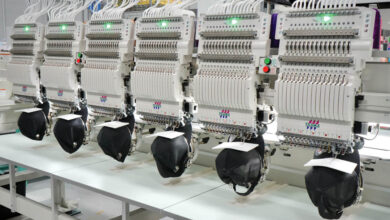The first way to reduce the bulk of embroidery stabilizer is by not using too much stabilizer when you embroider. Too many times, I see embroiderers trying to solve digitizing problems by stiffening the garment with excessive stabilizer. You might encounter inadequate pull compensation or lack of proper overlaps causing gaps or making outlines fall out of register. This doesn’t mean you should layer up excessively.
If you are using more than one piece of medium-weight cutaway on a garment, you should ask yourself whether you are compensating for poor digitizing, inadequate hoop stability, or trying to put an overly-dense design on a light garment that can’t support it. A well-digitized design will have balanced densities, giving enough coverage to look complete in areas that are filled while not being bulletproof, overly stiff, or distorted. If you can’t fold a design readily, it’s almost assuredly too dense and/or you’ve used too much stabilizer.
The second way is to use stabilizers made for a lighter look. For example, poly-mesh stabilizers are very stable dimensionally, meaning that they don’t stretch readily in any one direction but are reasonably thin. One or sometimes two layers of offset poly-mesh stabilizer can hold up to a great deal of distortion while being thinner and more flexible than a traditional cut-away stabilizer. Consider lighter stabilizers made for light and stretchy materials like performance wear to keep those gauzy substrates from being weighed down.
A final way is to make sure you are carefully and completely removing the excess stabilizer. Don’t leave any “corners” on the resulting cut shape. Cut around the shape of your design as to not cut between floating elements. Contour some short distance, no more than a 1/2 inch away from the design, making sure to round any corners as you cut the stabilizer. Leave as organic and soft a shape as you can. Sharp corners and squares make noticeable edges and shadows when a garment is pressed against the stabilizer as one wears it. That softer shape can make a difference.
As for wash-away stabilizers, be careful. It may seem nice to have a stabilizer wash away entirely, but without that stabilizer, there’s no support for the mass of thread in the design and any unconnected elements are now free to move separately if the garment is stretched or distorted. This can make lettering look crooked, elements spread apart, and can cause the garment to look like it’s being weighed down directly by the stitching as the stresses and weight aren’t spread to the wider area of the stabilizer. Moreover, even very light stitching may appear loose or loopy after stabilizer is washed away and the backing had enough thickness to affect the tension of the stitches. Some wash-away stabilizers are not totally soluble, leaving behind some fibrous material. This may help the last issue but does nothing for cohesiveness in the design.
In general, the rule is simple. Use only what you need to get the effect you want, leave behind only what’s necessary, and think of the embroidery as a holistic balance between garment, design, and stabilizer. Get that balance right and you can get the hand your customers want in your work.
—ErichCampbell.com



